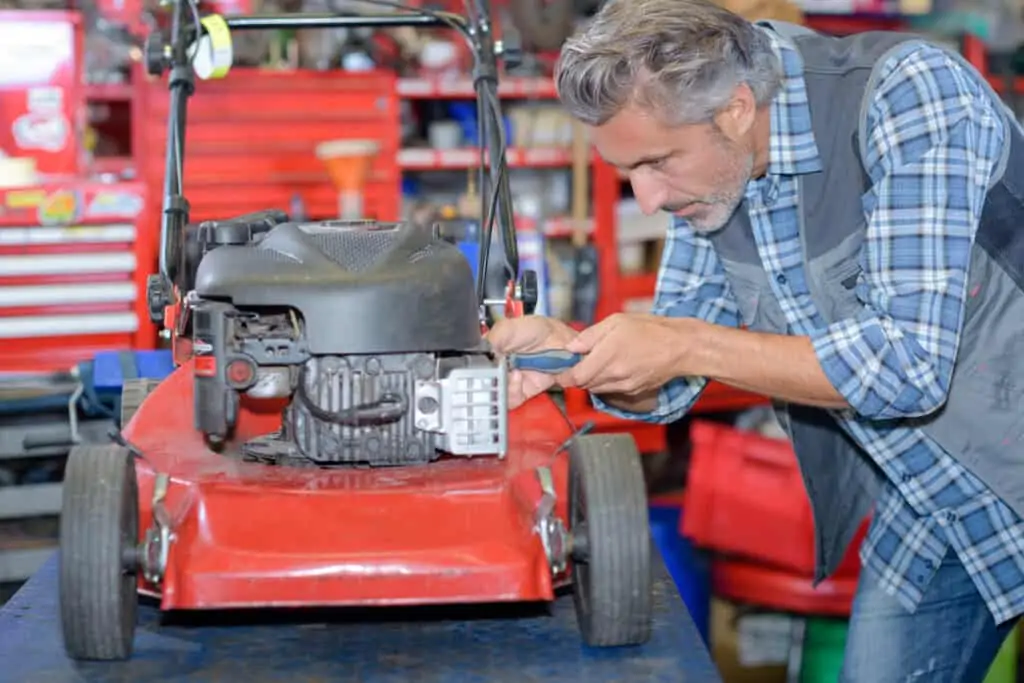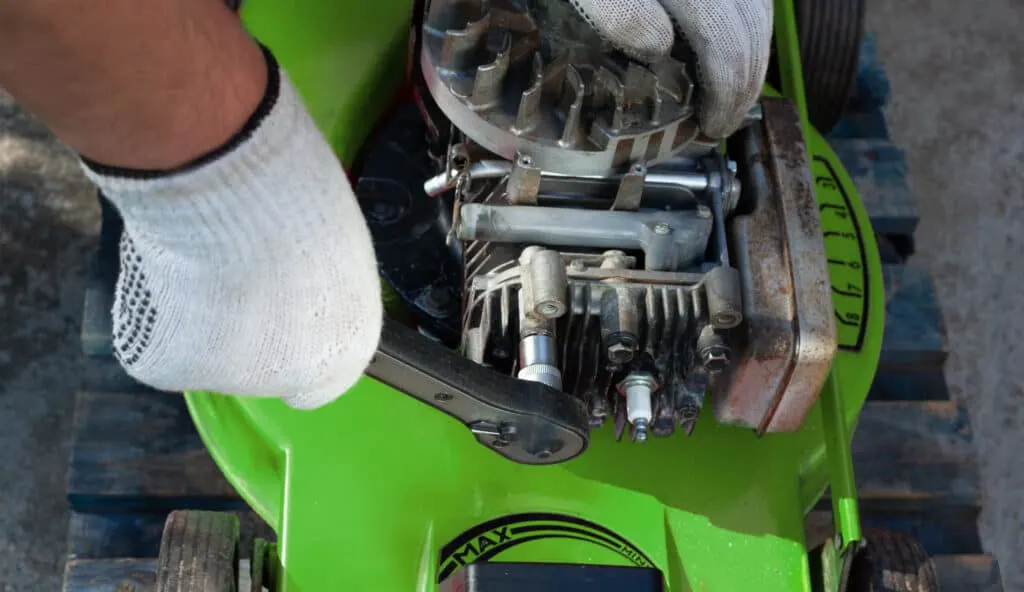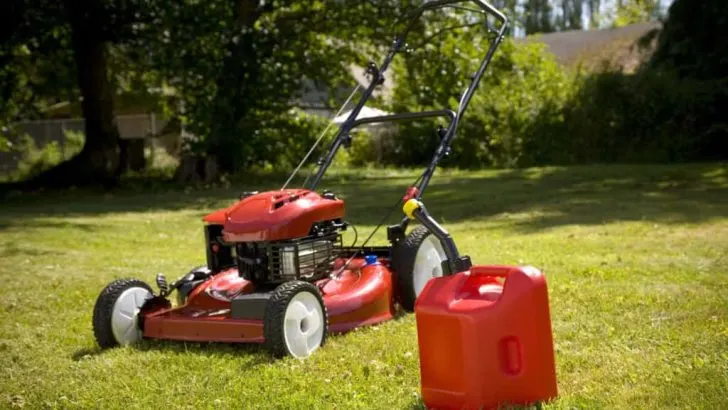There is quite a lot that goes into the process of troubleshooting a lawnmower that stops running. That process becomes especially tricky when the lawnmower only runs on choke. That being said, how can you troubleshoot your lawnmower when it runs on choke?
To troubleshoot a lawnmower that runs on choke, clean out any build-up of dirt, rocks, and debris of any kind, fix wear-and-tear on the spark lead and cables, secure and fasten the primer bulb and any screws or bolts in the carburetor and the spark plug, put in new fuel, and start the choke.
There is more to the process, but those are some good general steps to follow when you’re trying to diagnose the problem. Now that you’ve seen the brief overview, let’s look more in-depth into the process and the logistics of how it is done.
Necessary Tools for Troubleshooting a Lawn Mower
The following tools will be used in one of the potential problem areas during the troubleshooting process:
- Socket Wrench Set
- Combination Wrenches
- Plug Spanner
- Screwdrivers
- Magnetic Tray
- Torque Wrench
- Feeler Gauge
The Initial Trouble Shooting Checklist
This is the initial list for troubleshooting a lawnmower (including specifics for lawnmowers that run on choke). More details on the steps are given following the list.
- Use fresh gas.
- Firmly attach the spark lead and tightly twist and screw in the plug.
- Firmly hold the lever used to start the engine to the handle of the lawn mower.
- Turn on the choke. Make sure to start this step at least more than five minutes after the last instance when the lawn mower’s engine was still running.
- Press the primer bulb roughly five times. Prime it again if necessary.
- Check on the status of the air filter. Is it dirty? Does it need to be replaced? If it does end up being dirty when checked on, one option to take care of that is to wash the air filter.
- Check for damage or wear and tear on the cable that connects the engine to the lever used to start the lawn mower.
- Make sure the Carburetor is screwed in tight and secure.
- Check for water lying in the bottom of the lawn mower’s gas tank. Remove any water that is there if applicable.
- Check for anything that may be clogging or blocking the starter chord when it is being pulled.
- Check the muffler.
First Potential Problem: The Ignition System
The ignition starts it all. It causes the spark in the spark plug and then leads to combustion once it brings together the fuel and air. As such, checking the ignition system for any complications and maybe giving it a jump start is the best place to begin.
Check the wiring since the problem may be a short-circuit. Make sure all screws and bolts are secure and that the insulation is in good shape to help with that.

Second Potential Problem: The Flywheel Brake
The ability of the flywheel brake to operate congruously can make a night and day difference. If that capacity to run becomes impaired, the switch will short-circuit, the brakes will halt, and the cables may bust.
All three of those things will result in an engine that won’t start. Detach and disconnect the coiling on the top to fix the break on the inside and take care of the problem at hand.
To continue troubleshooting the lawnmower, remove the flywheel brake, test the operation points and set the gap. This can be done by using two clips (one on the capacitor and the other on the rocker arm), switch the millimeter to the lowest setting, and turn the crankshaft.
Third Potential Problem: The Carburetor
The primary purpose or function of the carburetor is to mix the fuel fluid with air. That process causes the internal combustion that is so critical for the lawnmower to work its magic.
If there is a blockage from the build-up of fuel residue in the fuel’s passageway, or in the bowl of the carburetor, or in any other relating areas, the carburetor will not be able to properly do its job. Cleaning out those areas and passageways will take care of that so the lawnmower will start back up.
Pro tip: If you notice that the mower will only start with starter fluid, there’s a good chance that the carburetor is in need of attention. The carburetor happens to be the cause of 90% of lawn mower problems.
Fourth Potential Problem: The Air Filter
Air is critical to the process happening inside the lawnmower that enables it to cut grass. That is why the air filter can make a night and day difference. When the air filter is dirty, there isn’t nearly as much air coming through as is necessary.
Not only that, but the dirtier it gets, the more problems may occur. Apart from the fact that the airflow is experiencing some restriction, there is crud collecting in and on the filter. All of the gunk that is building up in the filter can clog other spaces and cause some problems.
Sometimes the air filter needs to be replaced. Even with diligent maintenance, the time will come that its lifespan will reach an end and it will need to be removed. However, until that point, there is the option of cleaning it. This can only be done with certain types of air filters, or rather, air filters made out of specific materials (air filters made out of paper are a hard no).
When washing, use dish soap and ideally have the water around room temperature. Allow the air filter to completely dry before use, and don’t run the lawn mower’s engine without the air filter or else other components may potentially break.
Fifth Potential Problem: The Choke
Sometimes, the choke needs to be reset. The mixture of the fuel is conditional on the choke. If the choke isn’t functioning properly, there will be wrong proportions of the substances in the fuel which can cause further problems in other areas such as the carburetor.
Thankfully, this is a pretty easy fix. All that is needed is to reset the choke.
On the other hand, there could be other things in relation to the choke. It can’t be overworked or the combustion chamber in the carburetor will be bombarded with extreme amounts of fuel, causing the lawn mower’s engine to shut down.
At least in this circumstance, the problem takes care of itself for the most part if given enough time.
Letting the lawnmower sit and rest for a bit (ideally for several hours) will allow it to gradually drain the excess fuel that caused the engine to stop. If it has had enough time to take care of that, but still isn’t working, the choke switch may need to be fixed.
Sixth Potential Problem: The Fuel Mixture
The fuel may have been tainted by other substances. If that is the case, it will interfere with the combustion in the engine and the lawnmower won’t work. It is easy to take care of though.
Let the lawn mower have time to clear out the contaminated fuel, clean the fuel tank, refill the tank with new fuel, and the problem is solved.
Seventh Potential Problem: The Blade
For the lawnmower to be able to work and effectively cut the grass, the blade needs to be in good condition. For that to be the case, it needs to be checked often. To troubleshoot a lawnmower when it stops working, the blade needs to be taken care of.
It should be pretty routine to remove and dispose of anything and everything that is jammed or congested in the blade. It is also good to make sure the blade isn’t too dull from time; however, that won’t specifically influence whether or not the lawnmower can start and work.
Eighth Potential Problem: The Spark Plug
There are two possible causes of issues with the spark plug. The first of the two is that it is broken or malfunctioning. In that case, the replacement of the spark plug should do the trick.
If the excess from the carbon on the spark plug is black and tacky or syrupy, that’s a good indicator that it is time to retire the spark plug and switch it with a new one. Something to take into account is that a deteriorating spark plug will diminish the fuel’s efficiency.
As for the second possibility, it could be that the spark plug is dirty. In other words, residue build-up, oil, dirt, and other debris could be creating a blockage. This could be prohibiting the spark from keeping the engine running for more than a few minutes.
A little cleaning with brake cleaner and a wire brush or replacing the plugs should eliminate any issues with the spark plug that could be interfering with the lawnmower. Also, make sure the spark plug gap is 0.03 inches.
The typical lifeline of the spark plug is a year to two years, and good maintenance will help it to last as long as possible.
Ninth Potential Problem: The Moisture
Moisture has the ability to mess with the throttle and engine of a lawnmower. Now, that being said, that doesn’t mean there can’t be moisture at all. Humidity, or water droplets from the grass, are perfectly fine for the most part. However, it shouldn’t really surpass that minimum.
The important part is keeping water on the outside so it doesn’t get inside the mechanisms of your engine.
Under the circumstance that the fuel line has water in it, check and fix it by securing the fuel line and making sure it is water-sealed. If that seems to be intact, look into the pipe for the same things and any breaks or punctures that the water pipe may have.
For larger amounts of water, give the lawnmower time to drain the water.

Tenth Potential Problem: The Muffler
On cars and lawnmowers alike, the muffler serves to minimize the noise level. For reasons such as an oil leak, grease, grime, or muck build-up and accumulation, the muffler may be working imperfectly.
When the muffler starts to malfunction, that snowballs into problems with the damper which causes the lawn mower’s engine to halt and stall. Once the muffler’s temperature has cooled off, take it off, empty it out, and clear through any build-up that is there.
Eleventh Potential Problem: The Battery
The lawnmower may stop running because the battery is dead. The easy and obvious solution for this problem is to jump-start the battery or charge it over a longer period of time. However, if the battery is totally flat, then it is time to replace it with a new battery.
Twelfth Potential Problem: The Fuel
There are a few different issues involving the fuel that could be causing problems. First, the fuel may be old. If it’s been sitting around in the tank for some time, it isn’t going to be very efficient. That being said, make sure to clean out the old fuel.
Topping the fuel tank with or merely adding newer fuel to the tank won’t solve anything. In other words, it’s out with the old, and in with the new. After emptying the old fuel out of the tank, clean any sticky residue that is left behind before adding the new fuel.
Check to make sure the correct fuel is being used. Using the wrong fuel is bad for the engine and messes with the internal combustion process. Therefore, it could be causing the problem that is keeping the lawnmower from working.
In that case, clear out the wrong fuel, clean the tank (if caught sooner than later, it should be a relatively quick and simple clean), and fill the tank with fuel that has the right octane.
As strange as it may seem, an air leak may cause problems with the fuel. Under the circumstance of an air leak, there will be a higher proportion of air in the fuel. The carburetor likes specific ratios, so the increase in the measure of air in the fuel will impede the engine’s function and cause it to respond in a finicky manner.
Plus, it causes there to be less fuel for use in the tank. Look for any ruptures and fractures in and around the carburetor, the gasket seal, and the fuel pipeline and replace or repair as needed to fix it.

